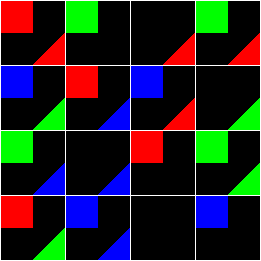Learning the graph - Introduction to the graph of game in the following

The whole graph is called a square, which is composed of 4*4 = 16 cells. The cells are separated with white lines. There are 2 shapes in them. The top-left one is a color rectangle (including black one, invisible). The bottom-right one is a color triangle ( including black one, invisible). Color rectangles and triangles have 4 colors each (including black one, invisible). Each color occurs 4 times each, total 4*4 = 16 color rectangles and triangles. The combinations of color rectangles and triangles in cells are all distinct. Rectangles and triangles have 4 colors each, total 4*4 = 16 cells of distinct color combinations. Each square has a black cell, which is swapped with the other cells (Refer to the following explanation). The perpendicular 4 cells are called a column and the horizontal 4 cells a row.
How to play - Introduction to how to play in the following
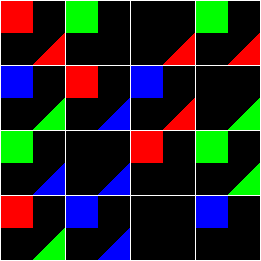
|
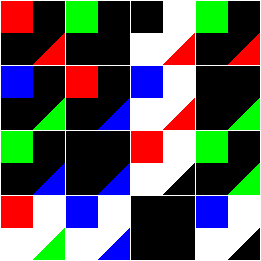
|
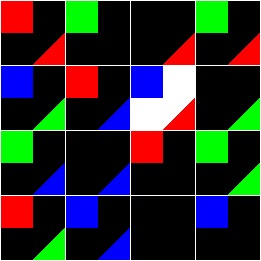
|
| Image 1 Square from the start | Image 2 Each of the 6 cells in the same column or row (marked white) can be swapped with the black cell | Image 3 Select one of the six cells in the left image (marked white) |
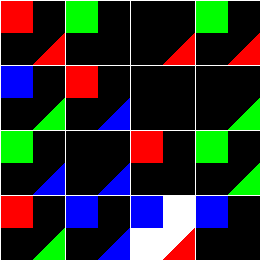
|
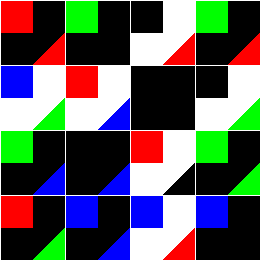
|
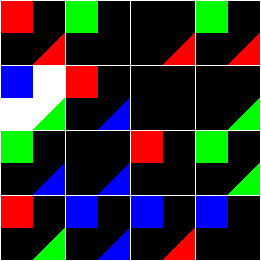
|
| Image 4 Result after swap | Image 5 Each of the 6 cells in the same column or row (marked white) can be swapped with the black cell | Image 6 Select one of the six cells in the left image (marked white) |
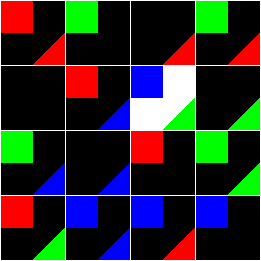
|
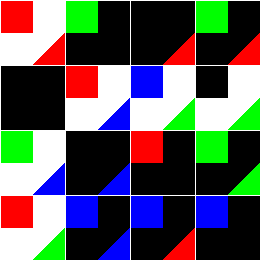
|

|
| Image 7 Result after swap | Image 8 Each of the 6 cells in the same column or row (marked white) can be swapped with the black cell | Image 9 Select one of the six cells in the left image (marked white) |
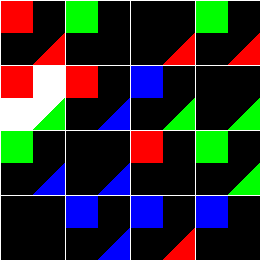
|
... | |
| Image 10 Result after swap | And so on |
Objectives - It explains the permutations of squares to complete in the following. The game is completed when any permutation in the following is achieved.
| Rule 1 Column-Row | |
|---|---|

|

|
| Image 1 Color rectangles in each column have distinct colors and in each row the same color. Color triangles in each column have the same color and in each row distinct colors. | Image 2 Color rectangles in each column have the same color and in each row distinct colors. Color triangles in each column are distinct colors and in each row the same color. |
| Rule 2 Column/Row-Latin | |
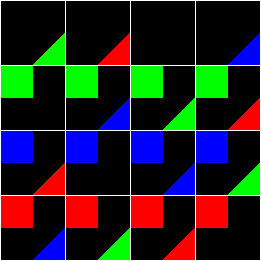
|
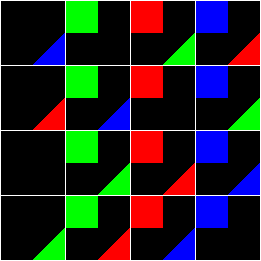
|
| Image 3 Color rectangles in each column have distinct colors and in each row the same color. Color triangles in each column have distinct colors and in each row distinct colors. | Image 4 Color rectangles in each column have the same color and in each row distinct colors. Color triangles in each column have distinct colors and in each row distinct colors. |
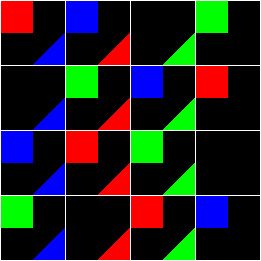
|
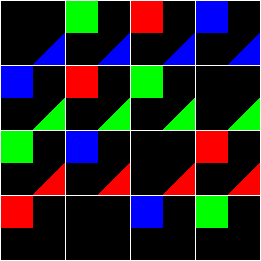
|
| Image 5 Color rectangles in each column have distinct colors and in each row distinct colors. Color triangles in each column have the same color and in each row distinct colors. | Image 6 Color rectangles in each column have distinct colors and in each row distinct colors. Color triangles in each column have distinct colors and in each row the same color. |
| Rule 3 Graeco-Latin | |
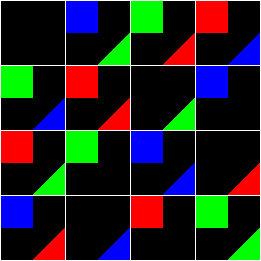
|
|
| Image 7 Color rectangles in each column have distinct colors and in each row distinct colors. Color triangles in each column have distinct colors and in each row distinct colors. | |
Comparisons of features of tetta and other intelligent games
| Features | tetta | N-Puzzle | Rubik's Cube | Sudoku | Tetris | Chess | Go | Contract Bridge | Poker |
|---|---|---|---|---|---|---|---|---|---|
| 1. Complexity of rules | ** | * | * | ** | ** | *** | ** | ***** | *** |
| 2. Start | Random | Random | Certain permutations | Certain givens | Blank | Fixed positions | Blank | Random | Random |
| 3. End | Complete certain permutations | Complete only one permutation | Same colors of six faces | Fill out the square according to the rules | Stack to the top | Checkmate or stalemate | Fill out the board and decide the winner | Show up all cards and decide the winners | All players except one fold, or compare the hands to decide the winner |
| 4. Complexity of variance | The higher order the more complex | The higher order the more complex | The higher order the more complex | The higher order the more complex | ** | ***** | The higher order the more complex | **** | ** |
| 5. Chance | No | No | No | No | * | No | No | *** | ***** |
| 6. Players | 1+ | 1+ | 1+ | 1+ | 1+ | 2 | 2 | 4 | 2+ |
| 7. Relationship between players | Everyone competes with each other | Everyone competes with each other | Everyone competes with each other | Everyone competes with each other | Everyone competes with each other | Two players play against each other | Two players play against each other | Two sides (two players per side) play against each other | Everyone competes with each other |
| 8. Competition on calculation | The lower order the more suitable | The lower order the more suitable | Only order of 2 is suitable | Depends on the difficulty | * | Only | Only | Only | Only |
| 9. Competition on reaction | The higher order the more suitable | The higher order the more suitable | Order of 3 or above is suitable | Only order of 3*3 or 4*4 is suitable | *** | No | No | No | No |
| 10. Computer time | Maybe very much when AI is used | Maybe very much when AI is used | Maybe very much when AI is used | Maybe very much when AI is used | * | Maybe very much when AI is used | Maybe very much when AI is used | Maybe very much when AI is used | * |
| 11. Replay to learn | Yes | Yes | Yes | No | No | Yes | Yes | Yes | No |
| 12. Educational function | Coordinate geometry, combinatorics, algebra | Coordinate geometry, combinatorics, algebra | 3D coordinate geometry, combinatorics, algebra | Coordinate geometry, combinatorics | Coordinate geometry, combinatorics, algebra | Coordinate geometry, combinatorics, algebra, game theory | Coordinate geometry, combinatorics, algebra, game theory | Combinatorics, probability, game theory | Combinatorics, probability, game theory |
Remarks:
- 1. Complexity of rule
- It refers to the difficulty of understanding rules.
- 2. Start
- It refers to the state of game start.
- 3. End
- It refers to the state of game end.
- 4. Complexity of variance
- It refers to the consequences of each move of player. the 19*19 go may be the most complex of all games.
- 5. Chance
- It refers to that the player is affected by hidden information.
- 6. Players
- It refers to the suitable number of players.
- 7. Relationship between players
- It refers to the relationship between players. "Compete with" means that the players are opponents but they cannot interfere with each other with moves. "play against" means the players are opponents but they can make bad interference to each other with moves.
- 8. Competition on calculation
- It refers to that the opponent players compete on more complete calculation.
- 9. Competition on reaction
- It refers to that the opponent players compete on shorter time of reaction to some situations.
- 10. Computer time
- It refers to the computrer time which the game costs.
- 11. Replay to learn
- It refers to that the player can record the gameplay and replay it for learning.
- 12. Educational function
- It refers to that the game can be an example of education. Here list only educational functions of mathematics.
